1995 GMC SIERRA warning light
[x] Cancel search: warning lightPage 139 of 488

NOTICE:
If you keep driving your vehicle with this light on, after a while
the emission controls
won’t work as well, your fuel economy
won’t
be as good, and your engine may not run as smoothly.
This could lead
to costly repairs not covered by your warranty.
Check Gages Light
This orange light will come on briefly when you are starting the engine. If
the light comes on and stays on while you are driving, it could indicate a
problem with your vehicle.
It could be a problem with your oil pressure.
coolant temperature, or some other problem. Check your various gages
to
see if they are in the warning zones. If they are, have your vehicle serviced
right away.
Daytime Running Lamps (DRL) Indicator Light
2-77
ProCarManuals.com
Page 185 of 488
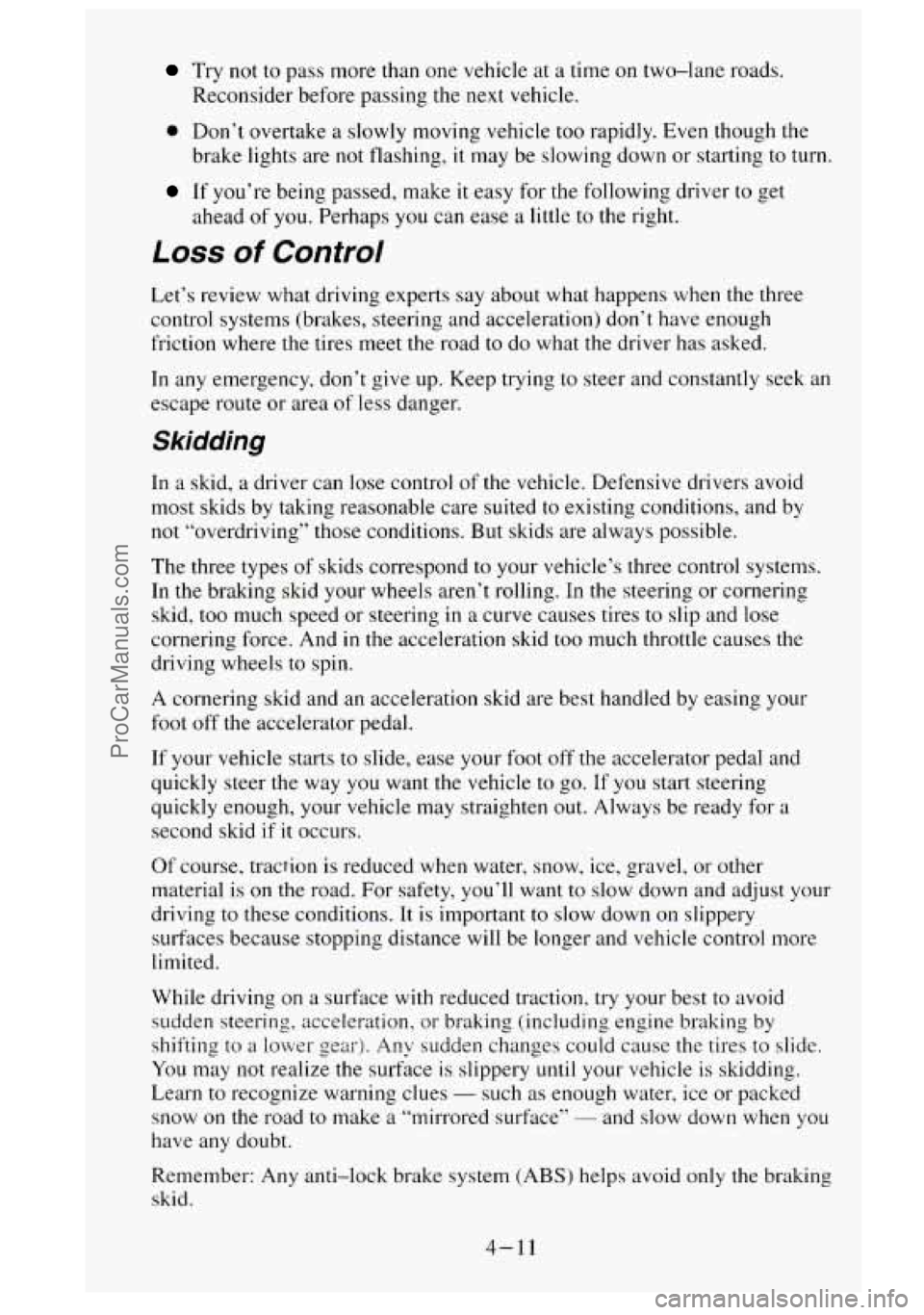
Try not to pass more than one vehicle at a time on two-lane roads.
Reconsider before passing the next vehicle.
0 Don’t overtake a slowly moving vehicle too rapidly. Even though the
brake lights are
not flashing, it may be slowing down or starting to turn.
If you’re being passed, make it easy for the following driver to get
ahead
of you. Perhaps you can ease a little to the right.
Loss of Control
Let’s review what driving experts say about what happens when the three
control systems (brakes, steering and acceleration) don’t have enough
friction where the tires meet the road
to do what the driver has asked.
In any emergency, don’t give up. Keep trying
to steer and constantly seek an
escape route or area of less danger.
Skidding
In a skid, a driver can lose control of the vehicle. Defensive drivers avoid
most skids by taking reasonable care suited
to existing conditions, and by
not “overdriving” those conditions. But skids are always possible.
The three types of skids correspond to your vehicle’s three control systems.
In the braking skid your wheels aren’t rolling. In the steering or cornering
skid, too much speed or steering in
a curve causes tires to slip and lose
cornering force. And
in the acceleration skid too much throttle causes the
driving wheels to spin.
A cornering skid and an acceleration skid are best handled by easing your
foot off the accelerator pedal.
If your vehicle starts to slide, ease your foot
off the accelerator pedal and
quickly steer the way you want the vehicle
to go. If you start steering
quickly enough, your vehicle may straighten out. Always be ready for
a
second skid if it occurs.
Of course, traction is reduced when water, snow, ice, gravel, or other
material is on
the road. For safety, you’ll want to slow down and adjust your
driving to these conditions. It is important to slow down on slippery
surfaces because stopping distance will be longer and vehicle control more
limited.
While driving on a surface
with reduced traction, try your best to avoid
sudden steering, acceleration. or braking (including engine braking
by
shifting to a lower gear). Any sudden changes could cause the tires to slide.
You may not realize the surface is slippery until your vehicle
is skidding.
Learn
to recognize warning clues - such as enough water, ice or packed
snow
on the road to make a “mirrored surface” - and slow down when you
have any doubt.
Remember:
Any anti-lock brake system (ABS) helps avoid only the braking
skid.
4-13
ProCarManuals.com
Page 201 of 488

0 0 Try to use the freeways that rim and crisscross most large cities. You’ll
save time and energy. (See the next part, “Freeway Driving.”)
Treat
a green light as a warning signal. A traffic light is there because
the corner is busy enough to need it. When a light turns green, and just
before you start to move, check both ways for vehicles that have not
cleared the intersection or may be running the red light.
Freeway Driving
Mile for mile, freeways (also called thruways, parkways. expressways,
turnpikes, or superhighways) are the safest of all roads. But they have their
own special rules.
The most important advice on freeway driving is: Keep up with traffic and
keep to the right. Drive at
the same speed most of the other drivers are
driving. Too-fast or too-slow driving breaks
a smooth traffic flow. Treat the
left lane on a freeway as a passing lane.
At the entrance there is usually
a ramp that leads to the freeway. If you have
a clear view of the freeway
as you drive along the entrance ramp, you
should begin to check traffic. Try to determine where
you expect to blend
with the flow. Try to merge into the gap at close to the prevailing speed.
Switch on your turn signal, check your mirrors and glance over your
shoulder as often
as necessary. Try to blend smoothly with the traffic flow.
Once you are on the freeway, adjust your speed to the posted limit or to the
prevailing rate
if it’s slower. Stay in the right lane unless you want to pass.
Before changing lanes, check your mirrors.
Then use your turn signal.
Just before you leave the lane, glance quickly over your shoulder to make
sure there
isn’t another vehicle in your “blind” spot.
Once you are moving on the freeway, make certain you allow
a reasonable
following distance. Expect
to move slightly slower at night.
4-27
ProCarManuals.com
Page 205 of 488
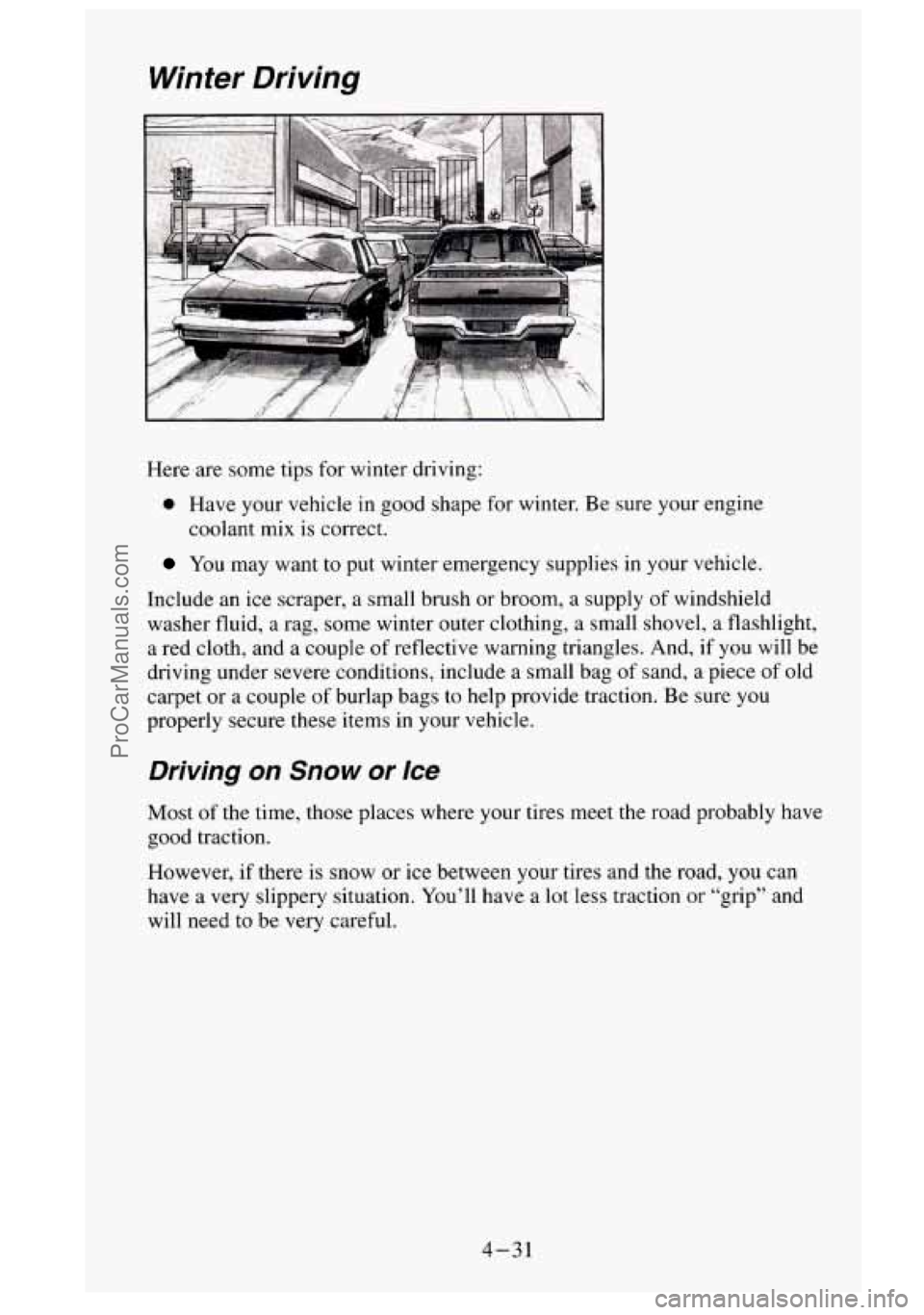
Winter Driving
Here are some tips for winter driving:
0 Have your vehicle in good shape for winter. Be sure your engine
coolant mix is correct.
You may want to put winter emergency supplies in your vehicle.
Include an ice scraper, a small brush or broom, a supply of windshield
washer fluid, a rag, some winter outer clothing, a small shovel,
a flashlight,
a red cloth, and a couple of reflective warning triangles. And, if you will be
driving under severe conditions, include a small bag
of sand, a piece of old
carpet or a couple
of burlap bags to help provide traction. Be sure you
properly secure
these items in your vehicle.
Driving on Snow or Ice
Most of the time, those places where your tires meet the road probably have
good traction.
However, if there is snow
or ice between your tires and the road, you can
have a very slippery situation. You’ll have a lot less traction
or “grip” and
will need to be very careful.
4-31
ProCarManuals.com
Page 272 of 488
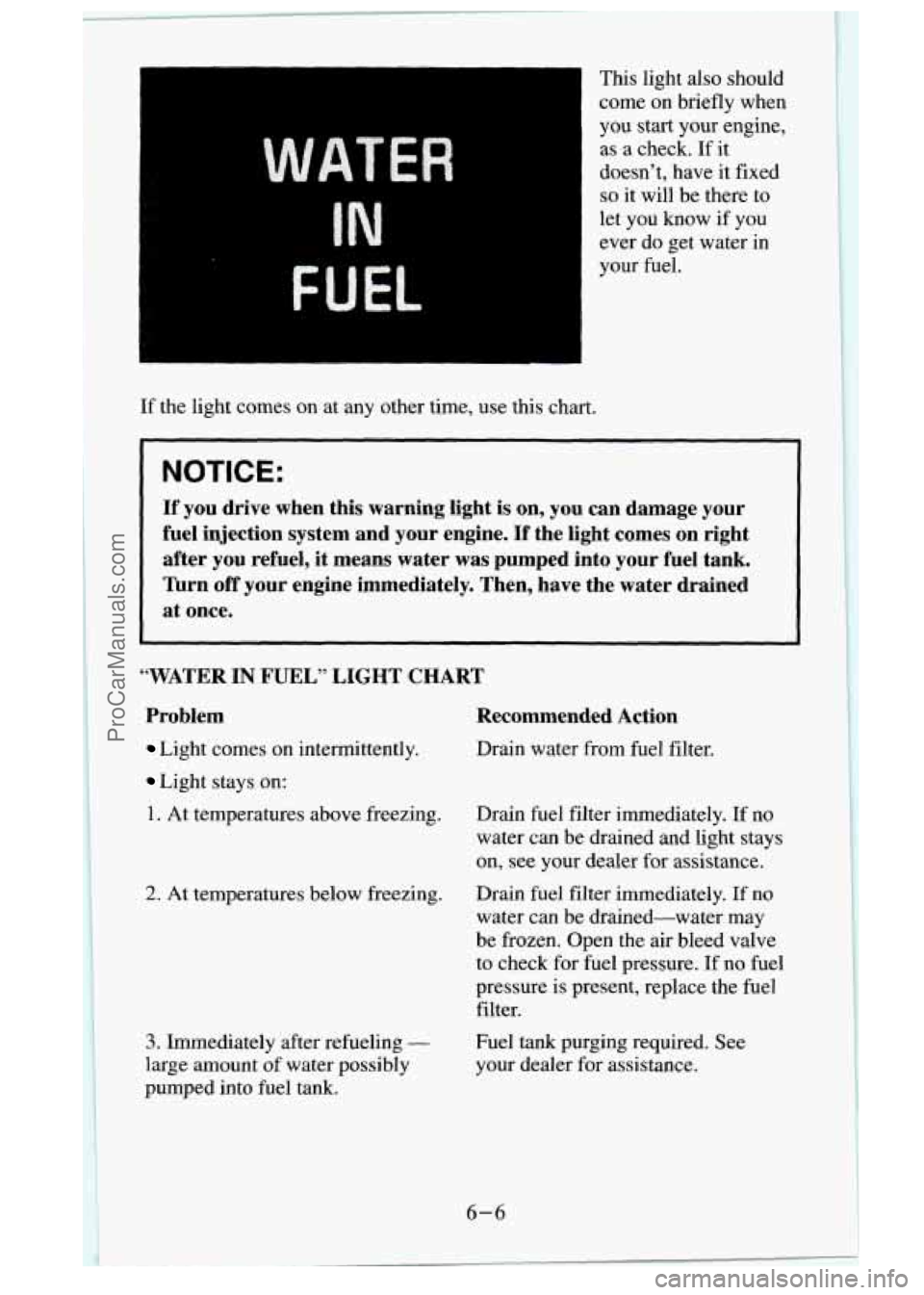
L
WATER
IN
FUEL
If the light comes on at any other time, use this chart. This light also should
come on briefly when
you start your engine,
as
a check. If it
doesn’t, have it fixed
so it will be there to
let you know if you
ever do get water in
your fuel.
If you drive when this warning light is on, you can damage your
fuel injection system and your engine.
If the light comes on right
after you refuel,
it means water was pumped into your fuel tank.
Turn
off your engine immediately. Then, have the water drained
at once.
“WATER IN FUEL” LIGHT CHART
Problem Recommended Action
Light comes on intermittently. Drain water from fuel filter.
Light stays on:
1. At temperatures above freezing.
2. At temperatures below freezing.
3. Immediately after refueling -
large amount of water possibly
pumped into
fuel tank. Drain fuel filter
immediately.
If no
water can be drained and light stays
on, see your dealer for assistance.
Drain fuel filter immediately.
If no
water can be drained-water may
be frozen. Open the air bleed valve
to check for fuel pressure.
If no fuel
pressure is present, replace the fuel
filter.
Fuel tank purging required. See
your dealer for assistance.
6-6
ProCarManuals.com
Page 310 of 488

Brake Wear
Your vehicle has front disc brakes and rear drum brakes. If you have a C
3500 HD model, it has four-wheel disc brakes.
Disc brake pads have built-in wear indicators that make
a high-pitched
warning sound when the brake pads are worn and new pads are needed. The
sound may come and
go or be heard all the time your vehicle is moving
(except when you are pushing on the brake pedal firmly).
I A CAUTION:
The brake wear warning sound means that sooner or later your
brakes won’t work well. That could lead to an accident. Whe\
n
you hear the brake wear warning sound, have your vehicle
serviced.
NOTICE:
Continuing to drive with worn-out brake pads could result in
costly brake repair.
Some driving conditions or climates may cause a brake squeal when the
brakes are first applied or lightly applied. This does not mean something is
wrong with your brakes.
If you have rear drum brakes, they don’t have wear indicators, but if you
ever hear
a rear brake rubbing noise, have the rear brake linings inspected.
Also, the rear brake drum should be removed and inspected each time the
tires are removed for rotation
or changing. When you have the front brakes
replaced, have the rear brakes inspected, too.
Brake linings should always be replaced as complete axle sets.
Brake Pedal Travel
See your dealer if the brake pedal does not return to normal height, or if
there is a rapid increase in pedal travel. This could be a sign of brake
trouble.
6-44
ProCarManuals.com
Page 473 of 488
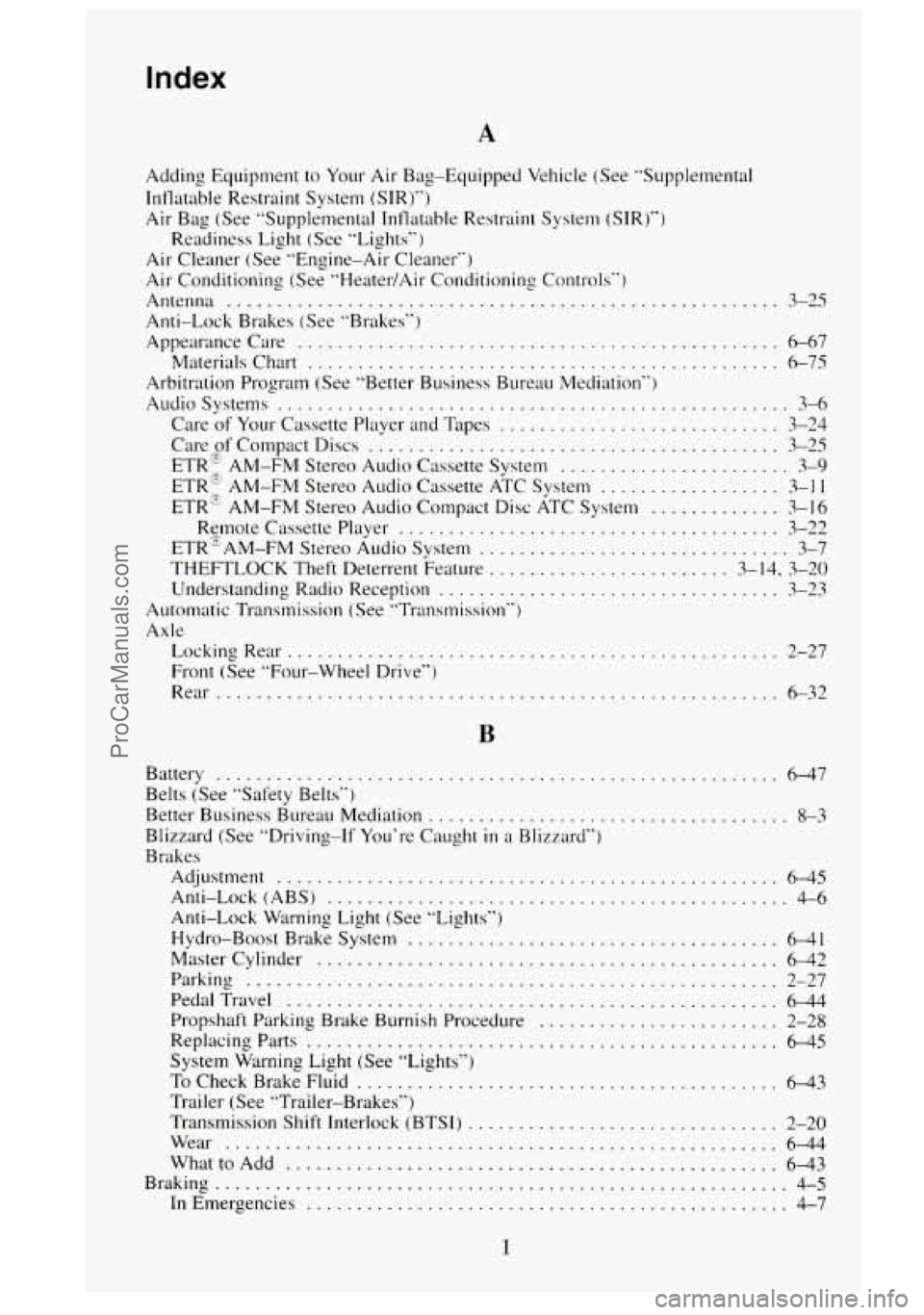
Index
A
Adding Equipment to Your Air Bag-Equipped Vehicle (See "Supplemental
Intlatable Restraint System (SIR)")
Air Bag (See "Supplemental Intlatable Restrain1 System (SIR)")
Air Cleaner (See "Engine-Air Cleaner")
Air Conditioning (See "HeatedAir Conditioning Controls")
Antenna
....................................................... 3-25
Readiness Light
(See "Lights")
Anti-Lock Brakes (See "Brakes")
Appearance Care
................................
Materials Chart ..............................
Arbitration Program (See "Better Business Bureau Media
Audio Systems
.................................
................ 6-67
................. 6-75
. tion")
.................. 3-6
Care of Your Cassette Player and Tapes ............................ 3-24
Care_of Compact Discs
......................................... 3-25
ETR: AM-FM Stereo Audio Cassette System
....................... 3-9
ETRf AM-FM Stereo Audio Cassette ATC System
.................. 3-11
ETR'?' AM-FM Stereo Audio Compact Disc ATC System ............. 3-16
Rcmote Cassette Player
...................................... 3-22
ETR&AM-FM Stereo Audio System
............................... 3-7
THEFTLOCK Theft Deterrent Feature
........................ 3- 14. 3-20
Understanding Radio Reception .................................. 3-23
Automatic Transmission (See "Tnlnsmission")
Axle LockingRea r
................................................. 2-27
Front (See "Four-Wheel Drive")
Rear
........................................................ 6-32
B
Battery ........................................................ 6-47
Belts (See "Safety Belts")
Better Business Bureau Mediation
.................................... 8-3
Blizzard (See "Driving-If You're Caught
in a Blizzard")
Brakes Adjustment
.................................................. 6-45
Anti-Lock (ABS)
.............................................. 4-6
Anti-Lock Warning Light (See "Lights")
Hydro-Boost Brake System
..................................... 6-41
Master Cylinder .............................................. 6-42
Parking
..................................................... 2-27
PedalTravel
................................................. 644
Propshaft Parking Brake Burnish Procedure
........................ 2-28
Replacingparts
............................................... 6-45
System Warning Light (See *'Lights")
To Check Brake Fluid .......................................... 6-43
Trailer (.See "Trailer-Brakes")
Transmission Shift Interlock
(BTSI) ............................... 2-20
Wear
....................................................... 6-44
WhattoAdd
................................................. 643
Braking ......................................................... 4-5
In Emergencies ................................................ 4-7
1
ProCarManuals.com
Page 477 of 488
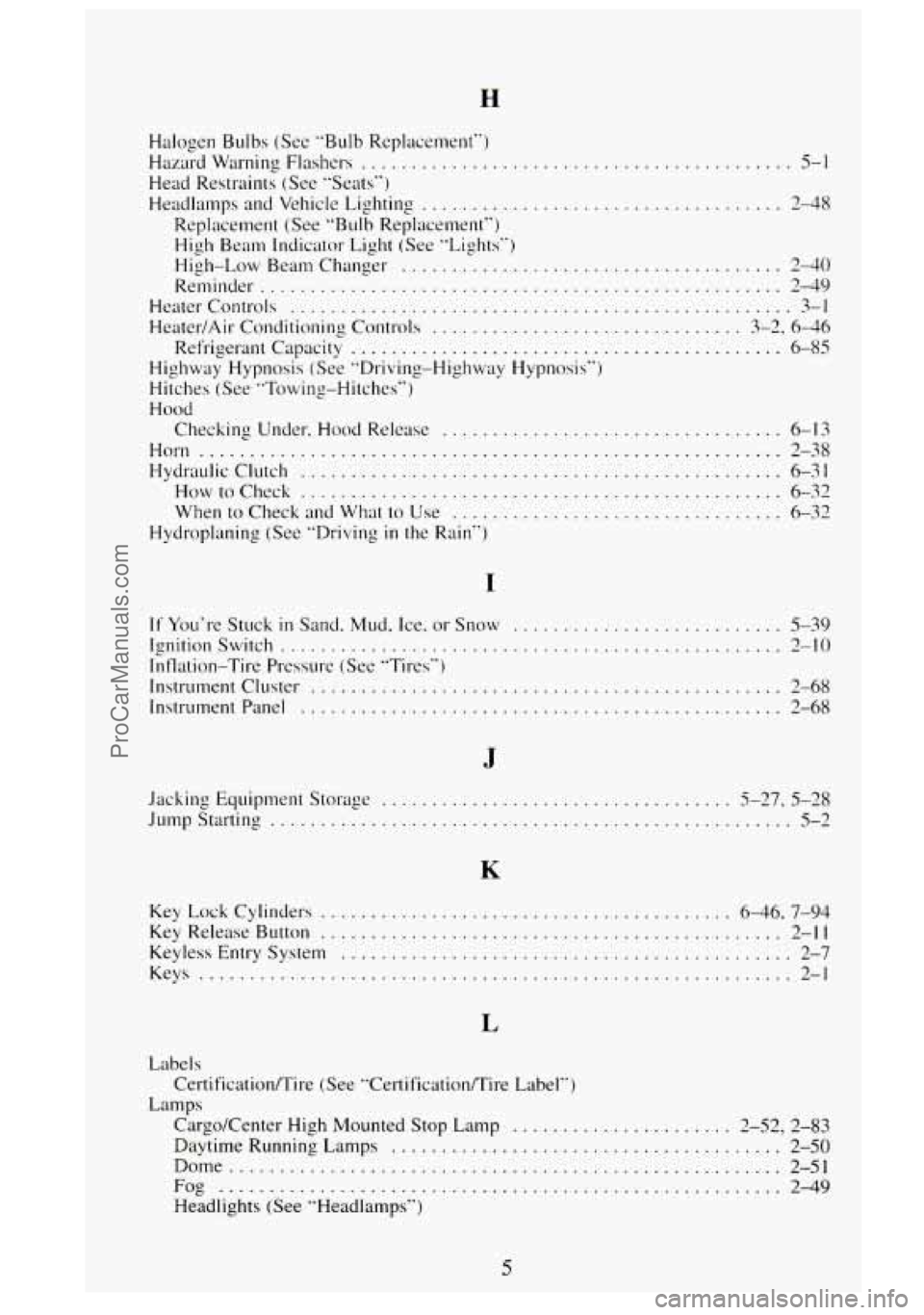
H
Halogen Bulbs (See "Bulb Replacement")
Hazard Warning Flashers
........................................... 5-1
Head Restraints (See "Seats")
Headlamps and Vehicle Lighting
.................................... 2-48
Replacement (See "Bulb Replacement")
High Beam Indicator Light (See "Lights")
High-Low Beam Changer
...................................... 240
Reminder .................................................... 2-49
Heater Controls .................................................. 3-1
Refrigerant Capacity ........................................... 6-85
Heater/Air Conditioning Controls ............................... 3-2 . 6-46
Highway Hypnosis (See "Driving-Highway Hypnosis")
Hitches (See "Towing-Hitches")
Hood
Checking Under: Hood Release .................................. 6-13
Horn .......................................................... 2-38
Hydraulic Clutch ................................................ 6-31
When to Check and What to Use ................................. 6-32
Howtocheck ................................................ 6-32
Hydroplaning (See "Driving in the Rain")
I
If You're Stuck in Sand . Mud. Ice . or Snow ........................... 5-39
Ignition Switch .................................................. 2-10
Intlation-Tire Prussure (See "Tires")
Instrument Cluster
............................................... 2-68
InstrumentPanel ................................................ 2-68
J
Jacking Equipment Storage ................................... 5-27 . 5-28
Jump Starting .................................................... 5-2
K
Key Lock Cylinders ......................................... 6-46.7-94
Key Release Button .............................................. 2-11
Keyless Entry System ............................................. 2-7
Keys
........................................................... 2-1
L
Labe 1 s
Lamps
Certification/Tire (See "CertificaticdTire Label")
CargdCenter High Mounted Stop Lamp
...................... 2.52, 2.83
Daytime Running Lamps ....................................... 2-50
Dome
....................................................... 2-51
Fog ........................................................ 2-49
Headlights
(See "Headlamps")
5
ProCarManuals.com